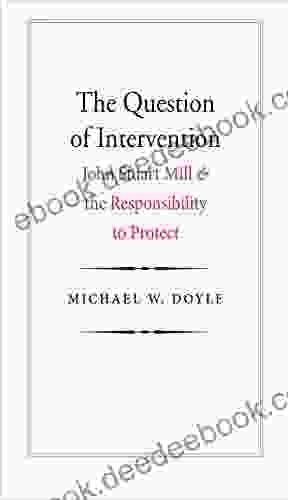The Question of Intervention: A Comprehensive Analysis

Intervention is a complex and controversial issue that has been debated for centuries. It is the act of one state or organization interfering in the affairs of another state or organization, typically to change the course of events. Intervention can take many forms, from diplomatic pressure to military force, and can be motivated by a variety of factors, such as humanitarian concerns, strategic interests, or economic gain.
There are many different perspectives on the question of intervention. Some argue that it is always wrong to interfere in the affairs of another state, while others believe that intervention is sometimes justified, such as when it is necessary to prevent genocide or other atrocities. There are also many different factors to consider when deciding whether or not to intervene, such as the likelihood of success, the potential costs and benefits, and the impact on the local population.
5 out of 5
| Language | : | English |
| File size | : | 7145 KB |
| Text-to-Speech | : | Enabled |
| Screen Reader | : | Supported |
| Enhanced typesetting | : | Enabled |
| Word Wise | : | Enabled |
| Print length | : | 288 pages |
In this article, we will explore the question of intervention in detail. We will consider the different perspectives on the issue, the factors that must be considered when deciding whether or not to intervene, and the potential consequences of intervention. We will also examine some specific cases of intervention, both successful and unsuccessful, to learn from the experiences of the past.
The Different Perspectives on Intervention
There are many different perspectives on the question of intervention. Some of the most common include:
- Non-interventionism: This is the belief that states should never interfere in the affairs of other states, regardless of the circumstances. Non-interventionists argue that intervention is always wrong because it violates the sovereignty of the target state and can lead to unintended consequences.
- Humanitarian intervention: This is the belief that states have a moral obligation to intervene to prevent genocide, ethnic cleansing, and other atrocities. Humanitarian interventionists argue that the protection of human life is more important than the sovereignty of the target state.
- Strategic intervention: This is the belief that states should intervene to protect their own national interests, such as by preventing the spread of terrorism or securing access to resources. Strategic interventionists argue that intervention is sometimes necessary to protect the state's security or economic well-being.
These are just a few of the many different perspectives on the question of intervention. There is no single right answer, and the best course of action will vary depending on the specific circumstances.
The Factors to Consider When Deciding Whether or Not to Intervene
When deciding whether or not to intervene, there are a number of factors that must be considered. These include:
- The likelihood of success: It is important to assess the likelihood of success before intervening. If the intervention is not likely to achieve its objectives, it may be better to avoid it altogether.
- The potential costs and benefits: The costs and benefits of intervention must also be carefully weighed. The costs can include both human and financial resources, while the benefits can include saving lives, preventing atrocities, or protecting national interests.
- The impact on the local population: Intervention can have a significant impact on the local population. It is important to consider how the intervention will affect their lives and livelihoods, and to take steps to minimize any negative consequences.
- The legitimacy of the intervention: The legitimacy of the intervention is also important to consider. If the intervention is not seen as legitimate by the local population or by the international community, it is less likely to be successful.
These are just a few of the factors that must be considered when deciding whether or not to intervene. The decision is a complex one, and there is no easy answer.
The Potential Consequences of Intervention
Intervention can have a number of potential consequences, both positive and negative. Some of the potential positive consequences include:
- Saving lives and preventing atrocities
- Protecting national interests
- Promoting democracy and human rights
Some of the potential negative consequences include:
- Causing more harm than good
- Destabilizing the region
- Damaging the reputation of the intervening state
The potential consequences of intervention must be carefully weighed before deciding whether or not to intervene.
Case Studies of Intervention
There have been many cases of intervention throughout history, both successful and unsuccessful. Some of the most notable examples include:
- The United Nations intervention in the Korean War (1950-1953): This was a successful intervention that prevented North Korea from taking over South Korea. The intervention was authorized by the United Nations Security Council, and it involved troops from many different countries.
- The United States intervention in the Vietnam War (1965-1973): This was a failed intervention that resulted in the deaths of over 58,000 American soldiers and an estimated 2 million Vietnamese civilians. The intervention was not authorized by the United Nations Security Council, and it was opposed by many people in the United States and around the world.
- The United Nations intervention in the Rwandan genocide (1994): This was a failed intervention that resulted in the deaths of over 800,000 people. The intervention was authorized by the United Nations Security Council, but it was too little, too late. The United Nations peacekeepers were not able to stop the genocide, and they were eventually withdrawn.
- The United States intervention in the Kosovo War (1999): This was a successful intervention that prevented Serbia from committing genocide against the Kosovar Albanians. The intervention was not authorized by the United Nations Security Council, but it was supported by many countries around the world. The intervention was successful in stopping the genocide and forcing Serbia to withdraw from Kosovo.
These are just a few of the many case studies of intervention. Each case is unique, and there is no single formula for success. However, the lessons learned from these cases can help us to make better decisions about intervention in the future.
The question of intervention is a complex one, with no easy answers. There are many different perspectives on the issue, and the best course of action will vary depending on the specific circumstances. However, by carefully considering the factors involved, we can make more informed decisions about intervention and increase the chances of success.
5 out of 5
| Language | : | English |
| File size | : | 7145 KB |
| Text-to-Speech | : | Enabled |
| Screen Reader | : | Supported |
| Enhanced typesetting | : | Enabled |
| Word Wise | : | Enabled |
| Print length | : | 288 pages |
Do you want to contribute by writing guest posts on this blog?
Please contact us and send us a resume of previous articles that you have written.
 Book
Book Page
Page Story
Story Genre
Genre Reader
Reader Paperback
Paperback E-book
E-book Magazine
Magazine Paragraph
Paragraph Sentence
Sentence Shelf
Shelf Preface
Preface Synopsis
Synopsis Manuscript
Manuscript Scroll
Scroll Codex
Codex Tome
Tome Classics
Classics Library card
Library card Narrative
Narrative Biography
Biography Autobiography
Autobiography Reference
Reference Dictionary
Dictionary Thesaurus
Thesaurus Narrator
Narrator Librarian
Librarian Archives
Archives Periodicals
Periodicals Scholarly
Scholarly Lending
Lending Rare Books
Rare Books Special Collections
Special Collections Interlibrary
Interlibrary Literacy
Literacy Thesis
Thesis Dissertation
Dissertation Storytelling
Storytelling Awards
Awards Reading List
Reading List Jon Liebman
Jon Liebman Stephen Catanzarite
Stephen Catanzarite Philip Taubman
Philip Taubman Tammie Rogers
Tammie Rogers Maya And Jello
Maya And Jello Will Clark
Will Clark Lana W Jackman Phd
Lana W Jackman Phd John Walsh
John Walsh Craig Speck
Craig Speck B Scott Christmas
B Scott Christmas Carol Copper
Carol Copper Zoey Dean
Zoey Dean N D Wilson
N D Wilson Lee Ragans
Lee Ragans C E Wilson
C E Wilson Nigel Mumford
Nigel Mumford Erik Morse
Erik Morse Ruth Phillips
Ruth Phillips Jorge Durand
Jorge Durand Susan Rose Ackerman
Susan Rose Ackerman
Light bulbAdvertise smarter! Our strategic ad space ensures maximum exposure. Reserve your spot today!

 Reed MitchellA Comprehensive History of American Political Parties: Evolution, Ideologies,...
Reed MitchellA Comprehensive History of American Political Parties: Evolution, Ideologies,... Federico García LorcaFollow ·4.8k
Federico García LorcaFollow ·4.8k Garrett BellFollow ·15.5k
Garrett BellFollow ·15.5k Gabriel HayesFollow ·14.6k
Gabriel HayesFollow ·14.6k Floyd RichardsonFollow ·7.6k
Floyd RichardsonFollow ·7.6k Chris ColemanFollow ·6.1k
Chris ColemanFollow ·6.1k Dwight BellFollow ·9.2k
Dwight BellFollow ·9.2k Jacob FosterFollow ·18.2k
Jacob FosterFollow ·18.2k William FaulknerFollow ·14.7k
William FaulknerFollow ·14.7k

 E.E. Cummings
E.E. CummingsThe Routledge International Handbook on Fear of Crime
Fear of crime is a serious problem that can...

 Fletcher Mitchell
Fletcher MitchellThe Hunchback in Hellenistic and Roman Art: A...
The hunchback, or kyphosis, is a physical...

 Victor Turner
Victor TurnerA Comprehensive Guide to Needle Felting for Moms:...
Needle felting, a captivating craft...

 Joseph Foster
Joseph FosterWhere is Scandinavia?
Scandinavia is a region in...

 Leon Foster
Leon FosterNovel Shades of Magic: A Masterpiece of Magical...
An Enthralling...
5 out of 5
| Language | : | English |
| File size | : | 7145 KB |
| Text-to-Speech | : | Enabled |
| Screen Reader | : | Supported |
| Enhanced typesetting | : | Enabled |
| Word Wise | : | Enabled |
| Print length | : | 288 pages |











